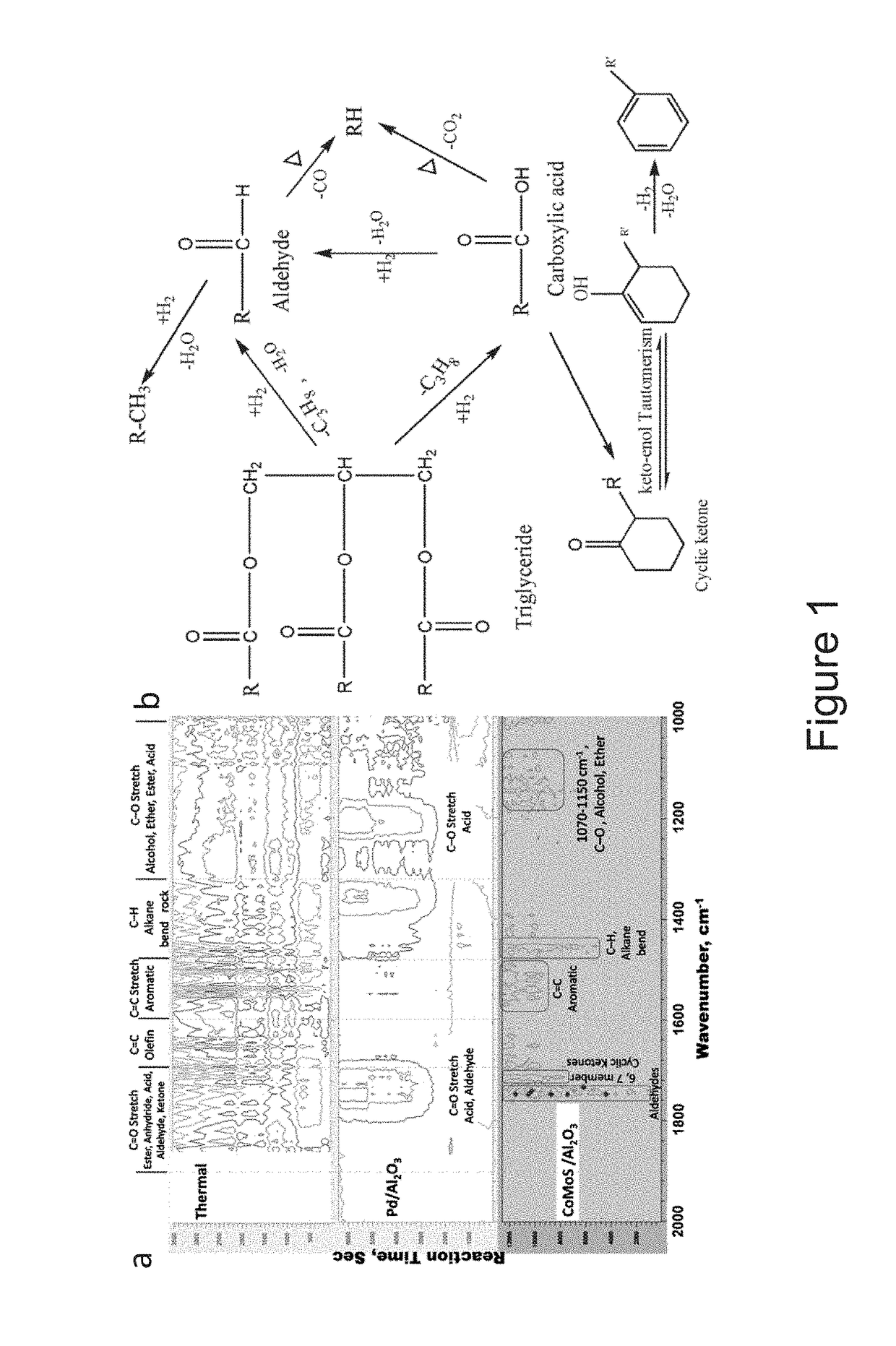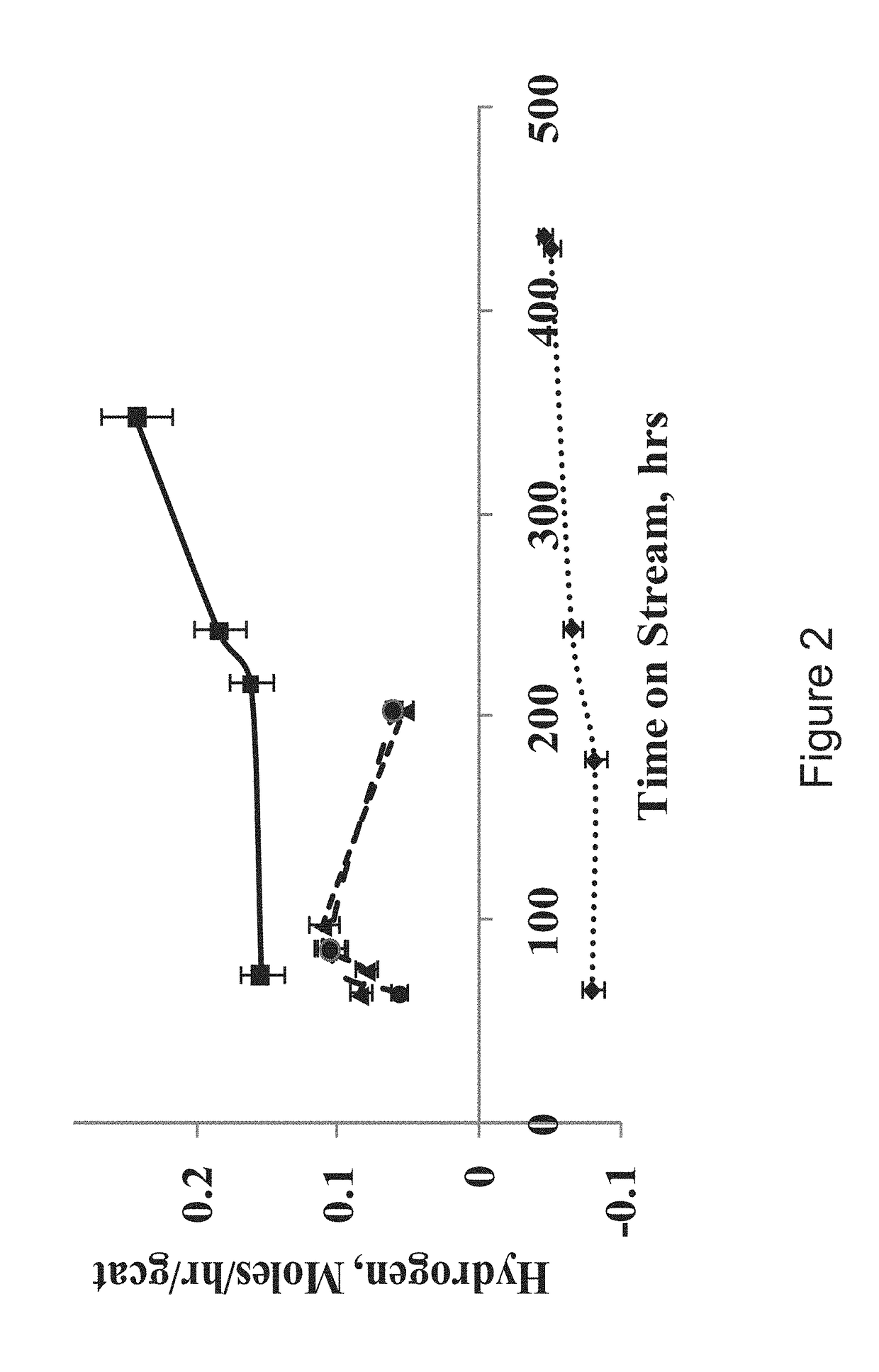H2 and bio-fuels production from renewable feedstocks
a technology of renewable feedstocks and biofuels, applied in bio-feedstocks, inorganic chemistry, chemical instruments and processes, etc., can solve the problems of difficult operation in a standalone operation mode, poor cold weather and poor emission, and the inability to use vegetable and animal oil as feed stocks directly in the engine or in the petrochemical complexes. to achieve the effect of minimal investmen
- Summary
- Abstract
- Description
- Claims
- Application Information
AI Technical Summary
Benefits of technology
Problems solved by technology
Method used
Image
Examples
example 1
[0026]Glycerides were processed in a fixed bed reactor with sulfided 4% CoO-16% MoO3-4% NiO / SiO2—Al2O3. The reaction conditions for the experiments were: 420′C, 30 bar, 1.5 h−1, and 2000 NL H2 gas / NL liquid feed. A total of 8% Naphthenes, 3.3% mono aromatics and 12.5% polynuclear aromatics were observed, with 15% yield of naphtha, 40% yield of kerosene and 45% yield of diesel range hydrocarbons and the isomer to normal hydrocarbon ratio was found to be 1.5. In addition, 3.36 liters / hr / gcat of hydrogen was produced in the reactor. The amount of hydrogen produced due to formation of naphthenes and aromatics was calculated to be 0.09 liters / hr / gcat which was less as compared to total hydrogen produced, indicating occurrence of other side reactions such as reforming, water gas shift leading to production of hydrogen in-situ with other hydrocarbons, water, CO and CO2.
example 2
[0027]Glycerides were processed in a fixed bed reactor with sulfided graded bed catalyst system, i.e. first bed of 4% CoO-16% MoO3-1% P2O5 / Al2O3 and the second bed of 4% NiO-16% MoO3 / SiO2—Al2O3. The reaction conditions for the experiments were: 460° C., 30 bar, 1.5 h-1, and 1500 NL H2 gas / NL liquid feed. A total of 11% Naphthenes, 8.7% mono aromatics and 5.5% polynuclear aromatics were observed, with 15% yield of naphtha, 25% yield of kerosene and 60% yield of diesel range hydrocarbons and the isomer to normal hydrocarbon ratio was found to be 1.1. In addition, 2.3 liters / hr / gcat of hydrogen was produced in the reactor. The amount of hydrogen produced due to formation of naphthenes and aromatics was calculated to be 0.1 liters / hr / gcat which was less as compared to total hydrogen produced, indicating occurrence of other side reactions such as reforming, water gas shift leading to production of hydrogen in-situ with other hydrocarbons, water, CO and CO2.
example 3
[0028]Glycerides were processed in a fixed bed reactor with sulfided graded bed catalyst system, i.e. first bed of 4% CoO-16% MoO3-1% P2O5 / Al2O3 and the second bed of 0.75% Pt encapsulated inside a sodalite cage catalyst (Pt@SOD). The encapsulation of the Pt prevents poisoning from sulfur compounds. Our earlier disclosed invention patent application 4093 / DEL / 2015 for development of such encapsulated catalytic systems included in the present invention by reference. The reaction conditions for the experiments were: 460° C., 50 bar, 1.5 h−1, and 1500 NL H2 gas / NL liquid feed. A total of 16% Naphthenes, 11.3% mono aromatics and 3% polynuclear aromatics were observed, with 20% yield of naphtha, 30% yield of kerosene and 50% yield of diesel range hydrocarbons and the isomer to normal hydrocarbon ratio was found to be 0.8. In addition, 2.3 liters / hr / gcat of hydrogen was produced in the reactor. The amount of hydrogen produced due to formation of naphthenes and aromatics was calculated to b...
PUM
| Property | Measurement | Unit |
|---|---|---|
| temperature | aaaaa | aaaaa |
| temperatures | aaaaa | aaaaa |
| pore size | aaaaa | aaaaa |
Abstract
Description
Claims
Application Information
 Login to view more
Login to view more - R&D Engineer
- R&D Manager
- IP Professional
- Industry Leading Data Capabilities
- Powerful AI technology
- Patent DNA Extraction
Browse by: Latest US Patents, China's latest patents, Technical Efficacy Thesaurus, Application Domain, Technology Topic.
© 2024 PatSnap. All rights reserved.Legal|Privacy policy|Modern Slavery Act Transparency Statement|Sitemap



